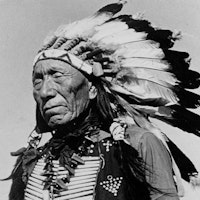In a Circle
Topic: The Natural World
Everything the Power of the World does is done in a circle. The sky is round, and I have heard that the earth is round like a ball, and so are the stars. The wind, in its greatest power whirls. Birds make their nests in circles, for theirs is the same religion as ours. The sun comes forth and goes down again in a circle. The moon does the same and both are round. Even the seasons form a great circle in their changing, and always come back again to where they were. The life of a man is a circle from childhood to childhood, and so it is in everything where power moves. Our tepees were round like the nests of birds, and these were always set in a circle, the nation’s hoop.
Heȟáka Sápa, commonly known as Black Elk, was born in December 1863 along the Little Powder River in what is now Wyoming. He was a member of the Oglala Lakota (Sioux) and a second cousin to the renowned war leader Crazy Horse. From a young age, Black Elk experienced profound spiritual visions that would shape his life and destiny. At the age of nine, during a severe illness, he had a vision in which he encountered the Six Grandfathers, spiritual beings who bestowed upon him gifts and powers, including the ability to heal. This vision set him on the path to becoming a wičháša wakȟáŋ, or holy man, a role he embraced throughout his life.
Black Elk's life was marked by significant historical events and personal transformations. He participated in the Battle of the Little Bighorn in 1876 and witnessed the tragic Wounded Knee Massacre in 1890. In the late 1880s, he traveled to Europe with Buffalo Bill's Wild West Show, where he sought to understand the ways of the white people. Upon returning to the United States, he became involved in the Ghost Dance movement, which aimed to restore the Native American way of life. Despite the suppression of this movement, Black Elk continued to serve his people as a healer and spiritual leader, blending traditional Lakota practices with his later conversion to Catholicism in 1904. He became a catechist, teaching Christianity while maintaining his Lakota spiritual beliefs.
Black Elk's legacy extends beyond his lifetime through his contributions to literature and spiritual teachings. His autobiographical accounts, shared with poet John G. Neihardt and anthropologist Joseph Epes Brown, were published in the influential works "Black Elk Speaks" and "The Sacred Pipe." These books have inspired generations and contributed to the revival of Native American culture and spirituality. Black Elk's ability to integrate his Lakota heritage with his Christian faith exemplifies his resilience and adaptability. His life and teachings continue to resonate, symbolizing a bridge between cultures and a testament to the enduring spirit of the Lakota people.
Black Elk Speaks
Black Elk, Nicholas, et al. Black Elk Speaks: Being the Life Story of a Holy Man of the Oglala Sioux. University of Nebraska Press, 2004, [Black Elk [Hehaka Sapa], Black Elk Speaks (1961)].

Black Elk [Heȟáka Sápa]
Theme: Natural World


About This Black Elk [Heȟáka Sápa] Quotation [Commentary]
Black Elk—Heȟáka Sápa—in Lakota begins with a direct teaching: “Everything the Power of the World does is done in a circle.” This is not just a natural fact but a way to recognize how sacred power moves. He names the roundness of the sky, the earth, and the stars. He points to the wind, which “in its greatest power whirls,” and the birds, who “make their nests in circles.” These forms are not merely practical; they reflect a shared pattern. “Theirs is the same religion as ours,” he says, linking human life with the ways of animals and the movements of the elements. The sun and moon “come forth and go down again in a circle,” and even time itself, through the seasons, returns “again to where they were.”
Black Elk’s focus remains on what is directly seen and deeply lived. “The life of a man is a circle from childhood to childhood,” he says, naming the arc of a life not as a straight path, but as a return. In this view, beginning and end are joined. The sacredness of the circle is not symbolic alone; it is visible in the structure of the world and the shape of human life. He draws no divide between spiritual insight and natural observation. Everything—light, time, weather, growth—moves with the same rhythm.
This circular form is also reflected in how his people lived. “Our tepees were round like the nests of birds,” he explains, “and these were always set in a circle, the nation’s hoop.” The round dwelling, the gathered circle, and the hoop of the nation all express the same pattern seen in the sun and stars. Black Elk offers no separation between the human world and the natural world. Both are formed by the same movement, shaped by the same power, and held together in the same circle.
Additional Black Elk Quotes
Related Quotes
Copyright © 2017 – 2025 LuminaryQuotes.com About Us